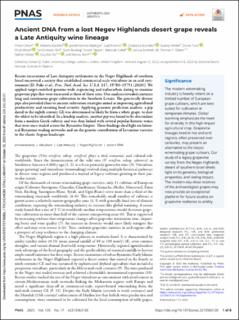| dc.contributor.author | Cohen, Pnina | |
| dc.contributor.author | Bacilieri, Roberto | |
| dc.contributor.author | Ramos-Madrigal, Jazmín | |
| dc.contributor.author | Privman, Eyal | |
| dc.contributor.author | Boaretto, Elisabetta | |
| dc.contributor.author | Weber, Audrey | |
| dc.contributor.author | Fuks, Daniel | |
| dc.contributor.author | Weiss, Ehud | |
| dc.contributor.author | Erickson-Gini, Tali | |
| dc.contributor.author | Bucking, Scott | |
| dc.contributor.author | Tepper, Yotam | |
| dc.contributor.author | Cvikel, Deborah | |
| dc.contributor.author | Schmidt, Joshua | |
| dc.contributor.author | Gilbert, Marcus Thomas Pius | |
| dc.contributor.author | Wales, Nathan | |
| dc.contributor.author | Bar-Oz, Guy | |
| dc.contributor.author | Meiri, Meirav | |
| dc.date.accessioned | 2023-11-06T08:38:02Z | |
| dc.date.available | 2023-11-06T08:38:02Z | |
| dc.date.created | 2023-05-02T09:38:32Z | |
| dc.date.issued | 2023 | |
| dc.identifier.citation | Proceedings of the National Academy of Sciences of the United States of America. 2023, 120 (17), . | en_US |
| dc.identifier.issn | 0027-8424 | |
| dc.identifier.uri | https://hdl.handle.net/11250/3100677 | |
| dc.description.abstract | Recent excavations of Late Antiquity settlements in the Negev Highlands of southern Israel uncovered a society that established commercial-scale viticulture in an arid environment [D. Fuks et al., Proc. Natl. Acad. Sci. U.S.A. 117, 19780–19791 (2020)]. We applied target-enriched genome-wide sequencing and radiocarbon dating to examine grapevine pips that were excavated at three of these sites. Our analyses revealed centuries long and continuous grape cultivation in the Southern Levant. The genetically diverse pips also provided clues to ancient cultivation strategies aimed at improving agricultural productivity and ensuring food security. Applying genomic prediction analysis, a pip dated to the eighth century CE was determined to likely be from a white grape, to date the oldest to be identified. In a kinship analysis, another pip was found to be descendant from a modern Greek cultivar and was thus linked with several popular historic wines that were once traded across the Byzantine Empire. These findings shed light on historical Byzantine trading networks and on the genetic contribution of Levantine varieties to the classic Aegean landscape. | en_US |
| dc.language.iso | eng | en_US |
| dc.publisher | National Academy of Sciences | en_US |
| dc.rights | Navngivelse 4.0 Internasjonal | * |
| dc.rights.uri | http://creativecommons.org/licenses/by/4.0/deed.no | * |
| dc.title | Ancient DNA from a lost Negev Highlands desert grape reveals a Late Antiquity wine lineage | en_US |
| dc.title.alternative | Ancient DNA from a lost Negev Highlands desert grape reveals a Late Antiquity wine lineage | en_US |
| dc.type | Peer reviewed | en_US |
| dc.type | Journal article | en_US |
| dc.description.version | publishedVersion | en_US |
| dc.source.pagenumber | 8 | en_US |
| dc.source.volume | 120 | en_US |
| dc.source.journal | Proceedings of the National Academy of Sciences of the United States of America | en_US |
| dc.source.issue | 17 | en_US |
| dc.identifier.doi | 10.1073/pnas.2213563120 | |
| dc.identifier.cristin | 2144608 | |
| cristin.ispublished | true | |
| cristin.fulltext | original | |
| cristin.fulltext | original | |
| cristin.qualitycode | 2 | |

